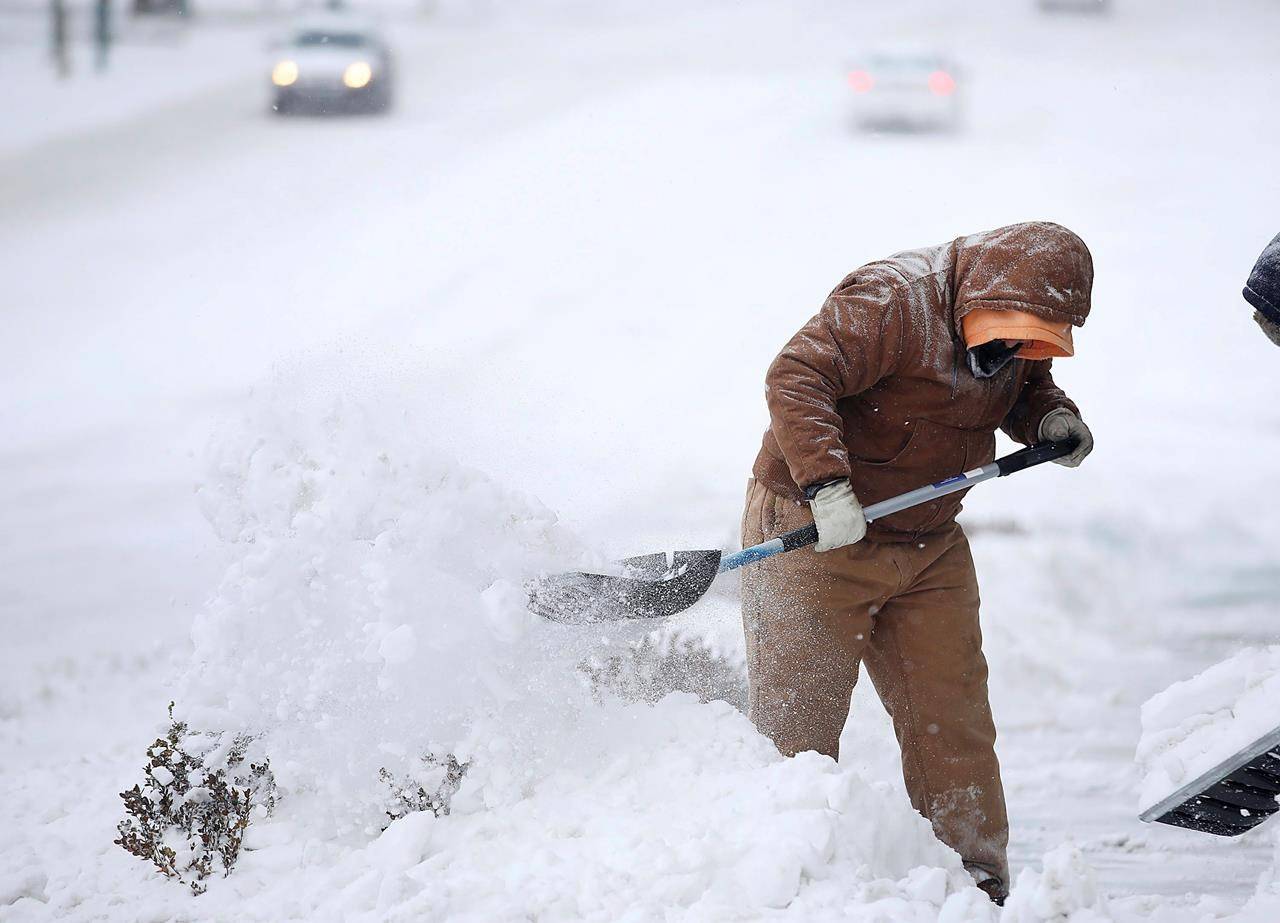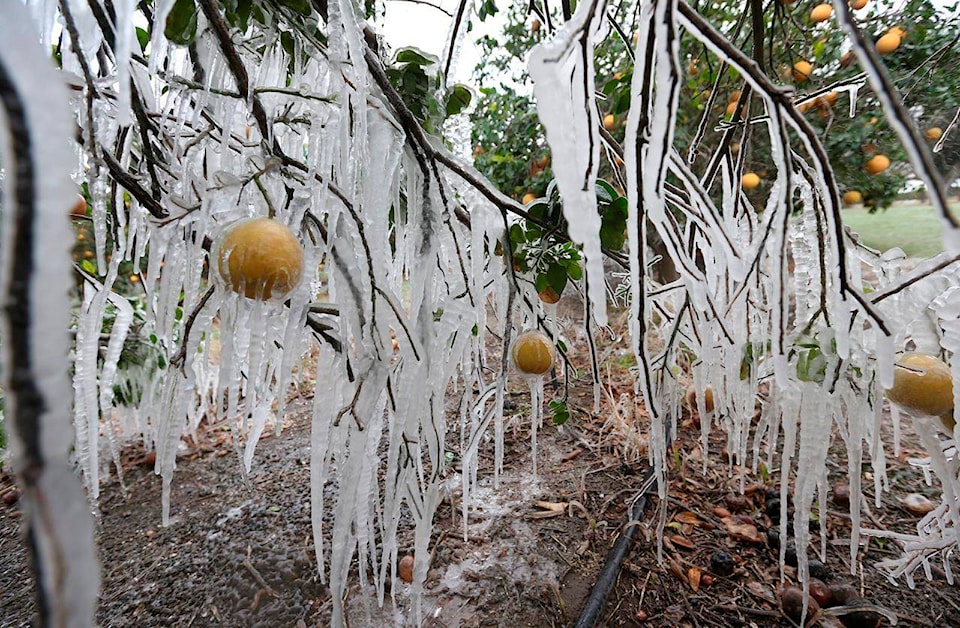AUSTIN, Texas — Utility crews raced Wednesday to restore power to nearly 3.4 million customers around the U.S. who were still without electricity or heat in the aftermath of a deadly winter storm while another blast of ice and snow threatened to sow more chaos.
The latest storm front was certain to complicate recovery efforts, especially in states that are unaccustomed to such frigid weather — parts of Texas, Arkansas and the Lower Mississippi Valley.
“There’s really no letup to some of the misery people are feeling across that area,” said Bob Oravec, lead forecaster with the National Weather Service, referring to Texas.
The system was forecast to move into the Northeast on Thursday. More than 100 million people live in areas covered by some type of winter weather warning, watch or advisory, the weather service said.
This week’s extreme weather has been blamed for the deaths of more than 30 people, some of whom perished while struggling to keep warm inside their homes. In the Houston area, one family succumbed to carbon monoxide from car exhaust in their garage. Another family died while using a fireplace to keep warm.
Weather-related outages have been particularly stubborn in Oregon, where some customers have been without power for almost a week.
Record low temperatures were reported in city after city. Scientists say the polar vortex, a weather pattern that usually keeps to the Arctic, is increasingly spilling into lower latitudes and staying there longer, and global warming caused by humans is partly responsible.
Utilities from Minnesota to Texas and Mississippi have implemented rolling blackouts to ease the burden on power grids straining to meet extreme demand for heat and electricity. In Mexico, rolling blackouts covered more than one-third of the country after storms in Texas cut the supply of imported natural gas.
The worst U.S. power outages by far have been in Texas, where 3 million homes and businesses remained without power as of midday Wednesday. The president of the state’s power grid manager, the Electric Reliability Council of Texas, said he hoped many customers would see at least partial service restored by later Wednesday or Thursday.
Dashawn Walker, 33, was thrilled Wednesday to find the power back on in his Dallas apartment. He stayed at a suburban hotel Tuesday night after being without power since Sunday, but said he was charged $474 for one night.
“It’s crazy,” Walker said. “I mean why would y’all go up on the hotels in the middle of a crisis?”
More than 200,000 additional customers were in the dark in four Appalachian states, and nearly that many in the Pacific Northwest, according to poweroutage.us, which tracks utility outage reports.
The outages in and around Portland, Oregon, affected nearly 150,000 customers nearly a week after a massive snow and ice storm toppled many trees and took out hundreds of miles of power lines.
The damage to the power system was the worst in 40 years, said Maria Pope, CEO of Portland General Electric. At the peak of the storm, more than 350,000 customers in the Portland area were in the dark.
“These are the most dangerous conditions we’ve ever seen in the history of PGE,” said Dale Goodman, director of utility operations, who declined to predict when all customers would have power restored.
Oklahoma and Nebraska avoided outages on Wednesday, a day after rolling blackouts stopped electric-powered space heaters, furnaces and lights in sub-zero weather. Oklahoma Gas & Electric warned customers of the potential for more short-term service interruptions due to the extreme cold and high demand for natural gas.
Rolling blackouts were imposed Tuesday in Arkansas, Louisiana, Mississippi and Southeast Texas at the direction of another grid manager, the Midcontinent Independent System Operator, according to a statement from the New Orleans-based utility Entergy.
The Southwest Power Pool, a group of utilities covering 14 states, said the blackouts were “a last resort to preserve the reliability of the electric system as a whole.”
The weather also caused major disruptions to water systems in several Southern cities, including in Shreveport, Louisiana, where city fire trucks delivered water to several hospitals, and bottled water was being brought in for patients and staff, Shreveport television station KSLA reported.
In Austin, Houston and other cities, residents were asked to stop letting water drip from pipes, a practice to prevent freezing, because of a major drop in water pressure. Houston residents also were told to boil their water, if possible, because the pressure drop allowed bacteria to seep into the pipes.
In the southwest Louisiana city of Lake Charles, Mayor Nic Hunter said Wednesday that water reserves remained low and local hospitals were faced with the possibility they might have to transfer patients to other areas.
Travel remains ill-advised in much of the United States, with roadways treacherous and thousands of flights cancelled. Many school systems delayed or cancelled face-to-face classes. But staying home can be hazardous in places without power.
Authorities said a fire that killed three young children and their grandmother in the Houston area likely was caused by the fireplace they were using to keep warm. In Oregon, authorities confirmed Tuesday that four people died in the Portland area of carbon monoxide poisoning.
At least 13 children were treated for carbon monoxide poisoning at Cook Children’s Medical Center in Fort Worth and one parent died of the toxic fumes, hospital officials said.
Stories of kindness emerged from the crisis.
In Clinton, Mississippi, Army veteran Evelyn Fletcher has been cooking and delivering meals to sidelined truck drivers, travellers and people staying at hotels after losing power at home.
“They’re stranded, they’re isolated — people are in need of support right now,” Fletcher said.
On Monday, Fletcher made 85 meals. On Tuesday, she made 30 plates, while a local restaurant, T’Beaux’s Crawfish and Catering, cooked 75 plates of shrimp and gumbo that she and other volunteers delivered. And on Wednesday, Fletcher was cooking a pot of turkey noodle soup, hoping to deliver another 70 meals.
“People are worried about more snow,” she said. “We are going to keep people fed and keep them feeling hopeful.”

